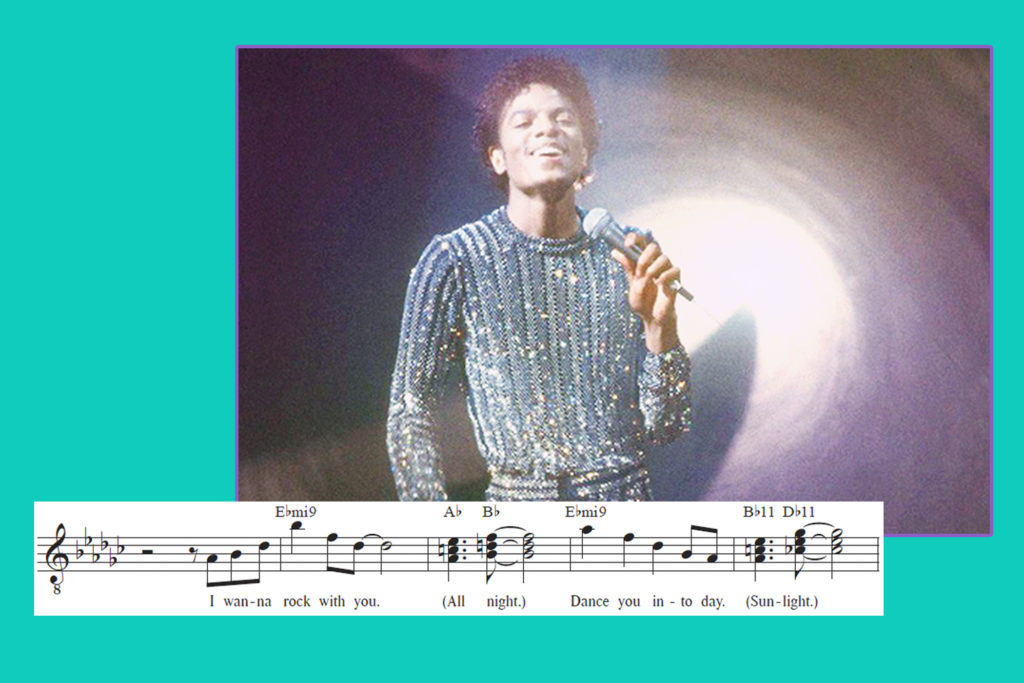+ Take your modern jazz piano and hip-hop beat making to new heights with Soundfly’s new course, Elijah Fox: Impressionist Piano & Production!
Jazz can be intimidating for a newcomer. If you write pop songs, and you want to start incorporating some jazz into your work, where do you start?
During the hundred or so years of its existence, jazz has spawned countless styles and sub-genres, from Dixieland and big band to bebop, free jazz, fusion, and beyond. Besides, while most modern pop songs rely only a handful of chords that get recycled into a limited set of chord progressions, jazz draws from a deep ocean of chord possibilities.
In fact, though, if you have basic music-reading skills, it’s not hard to start sprinkling in a little jazz. You can extend basic triads into jazz harmonies by strategically adding jazzy bonus notes. Conveniently, this article will talk about just this, introducing you to some common extended harmonies — sevenths, ninths, elevenths, and thirteenths.
Let’s do it!
Seventh Chords
As you may already know, the basic chords underlying most Western music of the last few hundred years, from Bach to Fall Out Boy, are called triads. Triads are major or minor chords built from the first, third, and fifth degrees of a major or minor scale, like these:

Put another way, a triad is a chord created by stacking two thirds. What if we stacked up one more? The new pitch would be the seventh scale degree. Here’s the result with a D major and a D minor scale:
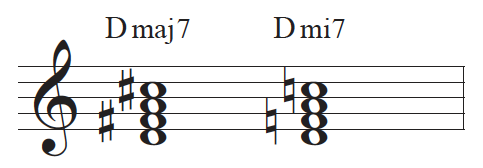
The chord built from the major scale is called a major seventh. And the other one is… you guessed it… a minor seventh.
There are many ways to notate these chords. A jazz player would see Amin7, Ami7, Ami7, or A-7 and know they all meant “minor seventh!” In this article, we’ll use “mi7” to indicate a minor seventh and “maj7” for a major seventh.
Another common seventh chord is the dominant seventh. Combining the third from the major scale and the seventh from the minor scale, it looks like this:
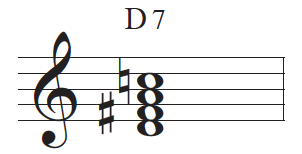
The dominant seventh plays an important role in classical music before the twentieth century. Notated as V7, it creates a dissonance that’s only resolved when it progresses to I, also called the tonic. Prolonging that resolution creates a wonderful tension that gives music energy.
You’ve heard this before:
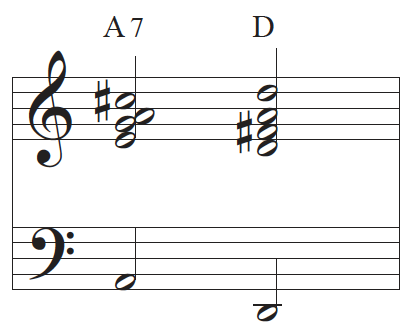
The G in that A7 chord is the seventh scale degree, and its mission is to resolve to the to the F# in the D chord. The C# will resolve to the D. Really, the V7 chord derives its entire meaning from the I. You’d never use an A7 chord in the key of A unless you intended to migrate to D. The V7 chord simply has no independent existence.
+ Read more on Flypaper: “How to Create Tensions With Your Chords.”
Jazz turns all this on its head. The seventh scale degree can resolve in the classical way, but it doesn’t need to. It can be not a dissonance, but a consonance. And the seventh chord isn’t obliged to resolve to any other chord. The A7 chord above is simply a slightly spicy version of the A triad. That A7 could be followed by all sorts of other chords, as in this progression:

Perhaps because the classical V7-I is still strong in our ears, the dominant seventh tends to create more tension than its major or minor siblings. In particular, the major seventh can be quite blissful. Even though the first and seventh scale degrees produce an interval that’s either a dissonant major seventh or a more dissonant minor second, if you put some distance between those two notes, the chord it exhibits a remarkable superstability.

There are other seventh chords, and variants of these three types abound, but these are the three you’ll find in most modern pop music.
Oh and one cool thing about 7ths…
We recently launched a video on our YouTube channel about the mysterious origins of the triangular symbol that has come to represent the major seventh on jazz charts. Theorists and curiosity-junkies, come one come all, and subscribe if you like that sorta thing!
Building a Progression
Let’s say you wanted to jazz up a progression of major and minor triads by adding sevenths. How would you choose among minor seventh chords, major seventh chords, or dominant sevenths?
First, if you add a major seventh to a minor triad, you get a minor-major seventh chord. That’s rare in pop music; so you’ll probably just want to extend that minor triad into a minor seventh chord. Major triads, however, present a choice, as you can convert them to either dominant or major seventh chords.
One approach would be to add the flavor of sevenths that fit the key and scale of the song. For example, let’s imagine a song that’s firmly in the key of A and uses the A major scale:

Let’s say this song uses the common chord progression: I – vi – ii – IV. In A, that’s A – F#m – Bm – D:

Let’s add to each chord a seventh from our A major scale. That gives us a mix of major and minor seventh chords. And it sounds quite natural.

Alternatively, we could make them all dominant sevenths, like this:

This works, too. Notice also how now the dominant F#7 pulls more strongly toward the B7 chord. But notice also that the B7 sounds slightly off. B7 contains a D# that’s foreign to the A major scale, and after the B7 moves to the D7, that D# still sticks in the ear.
What if we replaced B7 with Bmi7? That would change our D# to a D, a pitch that’s in our song’s A major scale. Now the progression feels quite smooth:

I really like the sound of the C♮ in the D7 chord. As C♮is the minor 3rd of A, it feels like a bluesy inflection. And it’s quite satisfying when the D7 returns to A7, and when the C♮ in the D7 moves to the C# in the A chord. I would switch out the Dmaj7 for the D7 in the first progression we created here as well.

What if we instead convert all these chords into major sevenths? That will introduce more pitches outside the scale, causing more clashes. You could use this progression, but it would sound more jarring, harder to pair with a catchy tune.

Harmonizing a Melody
If you’re looking to add jazz chords to an existing melody, the melody will guide your choices. You’ll probably want to choose chords that bring out interesting melodic pitches. You certainly won’t want chords that clash with the tune. You might choose chords that lend your melody a new perspective, but you’ll certainly want to support it.
Let’s say you were looking to harmonize a melody that began like this:

Let’s also say you want to use the chord roots A and F#.
To support the G# in the melody, the first chord would have to be Amaj7. A7 would include a clashing G♮:

If you changed those G#’s to G♮’s to make a more thoughtful, blues-inflected melody, you’d use A7 after all. But, for now, let’s keep the G#’s as G#’s. Our second chord could be F#7, F#mi7, or F#maj7. Each would work differently. F#7 would pull strongly toward the next chord, which might well be a Bmi7, creating a pleasing V7-I progression. F#mi7 would sound smooth, as it’s built from the same scale as the Amaj7. And F#maj7 would challenge the ear by introducing a clashing E#.

Ninth Chords
Stack another third on top of a seventh chord, and you get a ninth chord. Here are a dominant, minor, and major ninth chord:

So, when would you use a ninth chord?
Often, you’d do so to support a melody that contains that 9th. Take the little melody we looked at above. The second measure contains a strong expression of G#, a 9th over the F# chord root. We might well want to include that 9th in the chord.
Here’s how that sounds with an F# dominant, minor, and major ninth:

The ninth is the same in each of these chords. The seventh is what changes, so changing those (or the thirds) makes these chords sound different.
But ninths can change, too. If we changed the melody’s G#’s to G♮’s as above, we’d want the 9th to reflect that. We can do that by lowering the 9th a half-step. This is notated F#7(♭9). You’d rarely add a ♭9 to a major seventh, but let’s compare the dominant and minor 9ths with ♭9:

The F#mi7(♭9) is a little unusual, as its pitches don’t match any major or minor scale. But the dominant form, F#7(♭9), works well with a pop melody. The A# in this chord pulls strongly toward B, while the G♮ pulls strongly to F#. Thus we’d like to hear the F#7(♭9) followed by some form of Bmi.
The 9th scale degree has a tendency to resolve down to the first scale degree, or sometimes up to the 3rd, much as it would in classical music. But it doesn’t have to. Listen to the first bar of the chorus of Michael Jackson’s “Rock with You” (written by Rod Temperton and produced by Quincy Jones).
Here’s that written out:

The F is the ninth, and it doesn’t resolve. The melody simply arpeggiates its way through the upper pitches of the chord, and that’s fine.
You might want to add the ninth to the harmony to support a ninth in the melody. But you might just want to add the ninth for color, or to match the jazzy chord density of surrounding chords. Indeed, if you look at the lead sheet for a jazz standard, typically you’ll see a lot of seventh chords.
But jazz accompanists have great freedom to add chord tones, to modify the chord to match the moment. They can even change the chord root. And they might well add 9ths, 11ths, 13ths, suspensions, or more.
So, a pianist might well see the following progression we discussed above:

But they’d harmonize it like this:

Eleventh Chords
Stack another third on top of a ninth, and you get an eleventh.
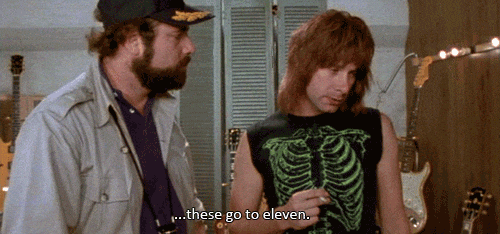
Here’s a sample, a G11 in all its glory:

Musicians normally omit the third (the B in this case), because it’s a half-step away from the 11th (the C), which would create a clash that’s generally (but not always) undesirable. Omitting the B from our G11 leaves a more typical voicing:
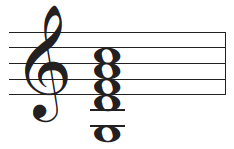
If the chord is a minor eleventh, the third is a half-step lower, and that clash vanishes. Even so, the third isn’t used much with minor elevenths either. The extended pitches are often the most interesting parts of the chord, and we don’t want a third sitting around distracting from those!
It’s not uncommon to omit the 5th from an eleventh chord as well. Here’s our G11 minus the 3rd and the 5th:
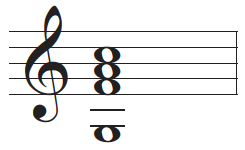
This chord, in this voicing, is such a characteristic sound of the disco era that I think of it as “the disco chord.” Just check out A Taste of Honey’s 1978 hit “Boogie Oogie Oogie.”
Listen to the groove at 0:31:

When the guitar plays that offbeat riff in the third bar, don’t you just think: “disco”?
The guitar’s actually playing a B♭ major triad. Placing that over a C in the bass creates the C11 experience. To make it clear that the G shouldn’t be included, you could also notate this as B♭/C, meaning: play a B♭ chord over a C bass.
And, yes, back when I played in a punk band that covered disco songs (it’s a long story) I remember telling the guitar player to play a major triad one full step higher than the bass, up high on the neck. He gave me a suspicious look, but he tried it. And — magic! — disco.
For more eleventh chords, let’s return to “Rock with You.” This time, listen to the first four bars of the chorus, at 0:51 in the track:

In the second bar, the harmony vocals sing “all night” on a chord whose high notes are E♭ and F. These are each a highly consonant fifth over the A♭ and B♭ chords. In the fourth bar, the harmonies shift ever so slightly, to E♭ and G♭. But the chords change significantly to B♭11 and D♭11. The chord roots lie a fourth below the new melodic notes.
Coupled with the disco eleventh chord, these introduce a wonderful, jazzy dissonance that gives the chorus an energy boost.
Notice also that the melody in the third bar descends by thirds, all the way down from the 11th scale degree (A♭) to the 5th (B♭). Elsewhere, I’ve called this technique the ladder of thirds.
The eleventh chord doesn’t feel much like a major or minor chord. After all, it no longer contains the third, or often the fifth. Instead, it’s a fascinating sort of stable dissonance all its own. It resolves well to a chord based on a root a fourth above, like this:

This feels like a cross between a V-I and a IV-I resolution. But it can really go almost anywhere!
Thirteenth Chords
Stack another third on an eleventh chord, and you get a thirteenth. Although this chord does pop up now and then in pop of the modern era, it isn’t common.
In jazz, like 9ths, 13ths can be added spontaneously for color. If I wrote “C7,” a pianist might well play this:

Among many other options they’d have, such as:

As we saw with 9ths and 11ths, you might want to use the 13th to accentuate a melody that contains that 13th (also known as a 6th).
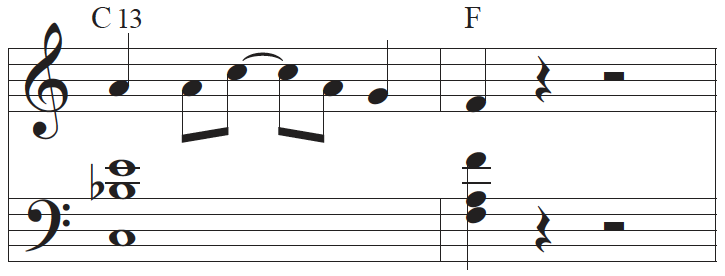
For a bluesy, minor inflection, you could add a flat 13th. To add more minor, bluesy emphasis you might even throw in a flat 9. This would be notated as C7(♭13)(♭9), which looks complicated, but which simply sounds satisfying:
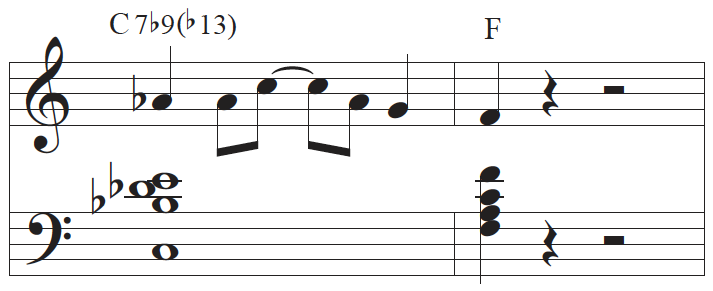
On the other hand, a #13 is enharmonically the same note as a dominant 7th. For example, the 13th in a C13 would be A. Raise that by a half-step, and you get A#, which sounds a whole lot like B♭, the 7th.
Thirteenths do sometimes appear in pop music. Here’s an example from a song that was more disco than disco, the Village People’s “Y.M.C.A.”
The song opens with our disco eleventh chord:
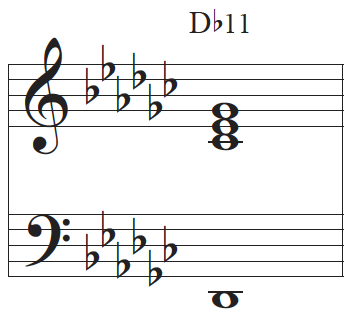
Notice how this sounds so stable, yet so exciting. A straight major chord or seventh chord would have a completely different effect.
Then, at 0:17 in the track, trumpets play this riff emphasizing B♭, the 13th:

I don’t hear the accompaniment ever actually playing the 13th, but it certainly joins the chord as the introduction progresses.
In Silk Sonic’s 70s throwback “Leave the Door Open,” at 2:46 in the track, a thirteenth chord caps the buildup from the bridge back to the verse.
The rich, complex thirteenth makes a perfect climax for the song’s adventurous middle section. A mere seventh chord would be such a disappointment:
Beyond Thirteenths
And that’s it! If you add another third onto a 13th, you’ll get a 15th, which is just the first scale degree up two octaves. So, there’s rarely a reason to discuss fifteenths in jazz.
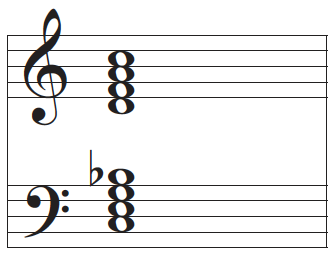
That didn’t stop the 20th-century composer and theorist Vincent Persichetti from talking about 15th and 17th chords in his book Twentieth-Century Harmony. After all, a #15 or ♭15 aren’t the same note as the chord root! But these extended pitches haven’t acquired a common function in any music I’m aware of (so we’re not going to discuss them here).
Now, You Try It
Don’t be afraid! If you’re a pop songwriter, this is the best time to try jazz harmonies since the 1970s. Everyone’s doing it, from R&B artists like SZA, Giveon, and H.E.R., to Top 40 artists like Dua Lipa, Justin Bieber, and Harry Styles, to rappers like Kendrick Lamar and Drake.
Why stick with the same old chords? Branch out. Expand your music. Expand your mind. Your listeners will appreciate it — and so will you!
Don’t stop here!
Continue learning with hundreds of lessons on songwriting, mixing, recording and production, composing, beat making, and more on Soundfly, with artist-led courses by Kimbra, Com Truise, Jlin, Ryan Lott, and the acclaimed Kiefer: Keys, Chords, & Beats.
